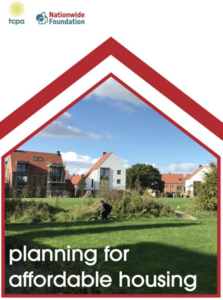Supplementary Guidance SG04 Affordable Housing
The document titled “Affordable Housing in Pakistan” explores the critical issue of housing accessibility for low- and middle-income families in the country. It highlights the growing demand for affordable housing due to rapid urbanization, population growth, and economic challenges. The document outlines various barriers to achieving affordable housing and presents potential strategies to address these challenges.
Current Housing Landscape
Pakistan faces a significant housing deficit, with millions lacking access to adequate shelter. The document emphasizes that many families live in informal settlements or overcrowded conditions due to the high costs associated with formal housing options. The lack of comprehensive housing policies and regulations has further exacerbated the situation, creating uncertainty for developers and hindering the development of affordable housing projects.
Key Challenges
Several key challenges impede the provision of housing affordability in Pakistan:
- Inadequate Policies: The absence of clear guidelines and standards for housing affordability projects creates obstacles for developers during planning and construction phases.
- High Land Prices: Rising land prices make it difficult for developers to offer affordable housing options, limiting access for low-income families.
- Limited Financing: Access to financing and mortgage facilities is restricted, making it challenging for low- and middle-income households to secure loans for home purchases.
- Informal Settlements: The proliferation of unplanned urbanization and informal settlements complicates the housing landscape, as many residents lack legal recognition and access to basic services.
Government Initiatives
In response to these challenges, the government has initiated several programs aimed at providing housing affordability:
Naya Pakistan Housing Program (NPHP)
The NPHP aims to construct five million housing units across Pakistan. It includes several components designed to facilitate affordable housing:
- Subsidies: Eligible applicants receive a subsidy of PKR 300,000 to lower their housing costs.
- Land Provision: Collaboration with provincial governments and development authorities ensures land availability at subsidized rates.
- Infrastructure Development: The program emphasizes the need for essential infrastructure, including roads, water supply, and sanitation services.
- Private Sector Engagement: By encouraging private developers to participate in affordable housing projects, the government aims to leverage additional resources and expertise.
Low-Cost Housing Models
The document outlines three models for implementing low-cost housing:
- Collaboration with Development Authorities: This model focuses on constructing low-cost housing on government-provided land in urban centers.
- Partnerships with Provincial Governments: This model emphasizes developing subsidized housing on government land in peri-urban areas using Engineering, Procurement, and Construction (EPC) methods.
- Private Sector Participation: Encouraging private developers to construct low-cost housing on privately owned land under specific conditions can enhance affordability.
Financial Mechanisms
To support these initiatives, various financial mechanisms are proposed:
- Tax Incentives: A 90% tax rebate is offered on approved projects under the NPHP.
- Mortgage Facilities: The government aims to facilitate access to mortgage financing through partnerships with banks, allowing low-income families to purchase homes more easily.
Addressing Barriers
The document acknowledges that overcoming barriers requires a multi-faceted approach:
- Comprehensive Housing Policies: Developing clear guidelines can streamline processes for developers and enhance coordination among stakeholders.
- Reducing Land Prices: Implementing measures such as land-use planning and providing incentives for housing affordability developments can help mitigate high land costs.
- Improving Access to Financing: Financial institutions should create flexible loan products tailored to low-income households’ needs, supported by government-backed mortgage guarantee programs.
Conclusion
Achieving affordable housing in Pakistan is a complex challenge that necessitates collaborative efforts from the government, private sector, and civil society. By addressing inadequate policies, high costs, limited financing options, and unplanned urbanization, significant progress can be made toward providing inclusive housing solutions. Housing affordability is not merely a basic need; it catalyzes social and economic development, poverty reduction, and improved quality of life. With concerted strategies and commitment from all stakeholders involved, Pakistan can work towards creating a more equitable society where every citizen has access to safe and affordable housing.
Further reading:
Affordable Housing in Pakistan: Challenges and Solutions- IIPS
[PDF] Affordable Housing – World Bank Documents and Reports documents1.worldbank
NAPHDA naphda.gov
PDF] Housing Barriers and Housing Strategies among Low Income

